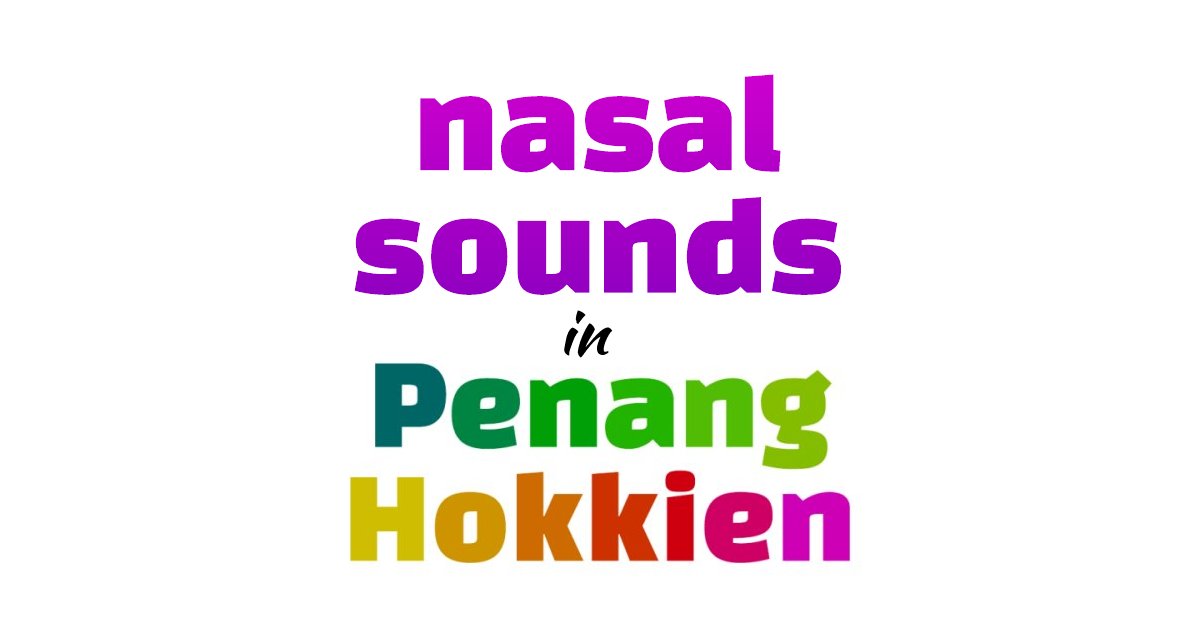
The presence of the nasal sound, particularly the voiced alveolar nasal, presents a challenge to writing Penang Hokkien. Many speakers of the language do notice the difference in pronunciation between the non-nasal and the nasal sound, but they have difficulties in distinguishing one from the other when writing. Traditional romanisation such as Church Romanisation (also known as Pe̍h-ōe-jī) represents the voiced alveolar nasal with a superscript n behind the final consonant, like this: an, en, in, on. This makes it challenging to write Church Romanisation on the ASCII-based keyboards and keypads, which diacritics, superscripts and unique letters require additional plug in or app. Taiwanese Romanization, a system based on Pe̍h-ōe-jī, partly solves the issue by added nn to the vowel, creating rimes such as ann, enn, inn and onn which are unfamiliar to most speakers of Penang Hokkien.
How the Nasal Sound is Represented in Taiji Romanisation
Taiji Romanisation leans on existing local spelling convention, in order for speakers of Penang Hokkien to correctly pronounce words based on intuition. From observation, it has been noted that some people nasalise by inserting an n between a preceding consonant and a succeeding vowel. This is adopted into the writing system.For example, the word for biscuit, a nasalized word, is spelled as pneah4
 in Penang Hokkien. Without the n, peah4 will sound like this:
in Penang Hokkien. Without the n, peah4 will sound like this:  In the same way, other nasalized words such as knia3
In the same way, other nasalized words such as knia3  (mirror) can be differentiated from kia3
(mirror) can be differentiated from kia3  (send), and snua1
(send), and snua1  (mountain) from sua1
(mountain) from sua1  (sand). Nasalized words that are already in common usage, such as ooi2
(sand). Nasalized words that are already in common usage, such as ooi2  (yellow) retain their spelling, even though they do not observe the convention.
(yellow) retain their spelling, even though they do not observe the convention.
Without a preceding consonant
If a preceding consonant is absent, a nasalized vowel sound is created by repeating the vowel letter before the n and twice again after it, creating a four-letter cluster with "n" being the second letter. Although the presence of the "n" in the middle may cause some to mistake it as two separate syllables, in practise this is not possible, as every syllable in Taiji has to end with a tone number.Carrier Syllable / Resulting IPA / Resulting Syllables
a1 

[ã]
anaa1 

anaa2 

anaa3 

anaa4 

i1 

[ĩ]
enee1 

enee2 

enee3 

enee4 

ae1 

[ɛ̃]
anae1 

anae2 

anae3 

anae4 

The three main nasalized sounds in Penang Hokkien are /ã/, /ĩ/ and /ɛ̃/, represented by the vowels a and i, and the digraph ae. Other nasalized sounds are usually formed in the presence of these three. Note that the "i" is represented by the "e" in the absence of an initial consonant, so enee1 instead of inii1. For IPA rendering, in diphthongs where both i and a are present, the tilde (~) is usually placed over the a. In Taiji, this does not matter, as no diacritic marks are employed. The "n" is the second letter after the initial consonant (i.e. pni4
 ), or third letter in an aspirated syllable (i.e. phni33
), or third letter in an aspirated syllable (i.e. phni33  ). Unlike Pe̍h-ōe-jī and Tâi-lô, there is no /ẽ/, /ɔ̃/ and other nasalized vowels.
). Unlike Pe̍h-ōe-jī and Tâi-lô, there is no /ẽ/, /ɔ̃/ and other nasalized vowels.
Learn Penang Hokkien with Memrise
Now you can use the most user-friendly tool on the web to learn Penang Hokkien. It helps you to listen, understand and memorise. Go to Memrise, and learn Penang Hokkien at your own pace.
Return to Penang Hokkien Resources
Latest from Discover with Timothy: Gurney Bay - what to see and do there
About this website

Hello and thanks for reading this page. My name is Timothy and my hobby is in describing places so that I can share the information with the general public. My website has become the go to site for a lot of people including students, teachers, journalists, etc. whenever they seek information on places, particularly those in Malaysia and Singapore. I have been doing this since 5 January 2003, for over twenty years already. You can read about me at Discover Timothy. By now I have compiled information on thousands of places, mostly in Peninsular Malaysia and Singapore, and I continue to add more almost every day. My goal is to describe every street in every town in Malaysia and Singapore.
Robbie's Roadmap
- Episode 1: Robbie's Journey to Financial Freedom
- Episode 2: Lost in America
- Episode 3: The Value of Money
- Episode 4: The Mentor
- Episode 5: The Thing that Makes Money
- Episode 6: The walk with a Billionaire
- Episode 7: The Financial Freedom Awakening
- Episode 8: Meet Mr Washington
- Episode 9: The Pizzeria Incident
Copyright © 2003-2024 Timothy Tye. All Rights Reserved.


 Go Back
Go Back